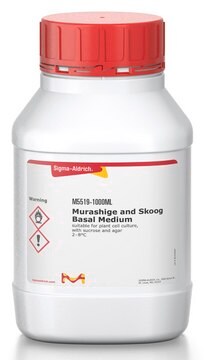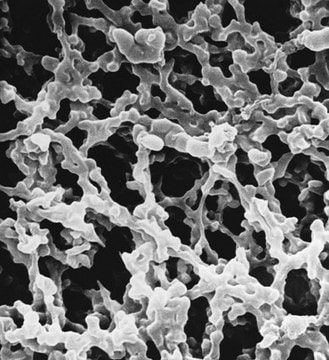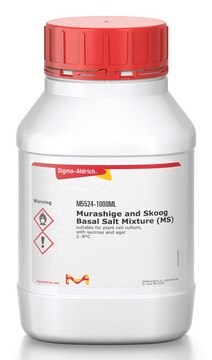A4550
Agar
Type A, suitable for plant cell culture
Synonym(s):
Agar-agar, Gum agar
About This Item
Recommended Products
biological source
algae (Rhodophyceae)
Quality Level
type
Type A
form
powder
technique(s)
cell culture | plant: suitable
transition temp
transition temp 32-38 °C (1.5%)
gel strength
>650 g/cm2
application(s)
agriculture
storage temp.
room temp
InChI
1S/C14H24O9/c1-5-8(16)13-11(7(21-5)4-20-13)23-14-10(18)12(19-2)9(17)6(3-15)22-14/h5-18H,3-4H2,1-2H3/t5?,6-,7?,8-,9+,10-,11?,12+,13+,14?/m1/s1
InChI key
GYYDPBCUIJTIBM-DYOGSRDZSA-N
Looking for similar products? Visit Product Comparison Guide
General description
Application
- to perform metal(loid)-related phenotyping of the Arabidopsis thaliana metal-sensitive mutant strains
- as a component of Murashige and Skoog (MS) media to culturing Arabidopsis thaliana seeds
- to culture Cicer arietinum L. (Chickpea) seeds for Agrobacterium rhizogenes mediated root transformation
Storage Class Code
11 - Combustible Solids
WGK
WGK 1
Personal Protective Equipment
Certificates of Analysis (COA)
Search for Certificates of Analysis (COA) by entering the products Lot/Batch Number. Lot and Batch Numbers can be found on a product’s label following the words ‘Lot’ or ‘Batch’.
Already Own This Product?
Find documentation for the products that you have recently purchased in the Document Library.
Customers Also Viewed
Our team of scientists has experience in all areas of research including Life Science, Material Science, Chemical Synthesis, Chromatography, Analytical and many others.
Contact Technical Service






